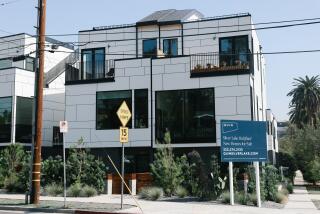After subprime collapse, nonbank lenders again dominate riskier mortgages

PennyMac, AmeriHome Mortgage and Stearns Lending have several things in common.
All are among the nation’s largest mortgage lenders — and none of them is a bank. They’re part of a growing class of alternative lenders that now extend more than 4 in 10 home loans.
All are headquartered in Southern California, the epicenter of the last decade’s subprime lending industry. And all are run by former executives of Countrywide Financial, the once-giant mortgage lender that made tens of billions of dollars in risky loans that contributed to the 2008 financial crisis.
This time, the executives say, will be different.
Unlike their subprime forebears, the firms maintain that they adhere to strict new lending standards to protect against mass defaults.
Still, some observers worry as housing markets heat up across the country and in Southern California, where prices are up by a third since 2012.
So-called nonbank lenders are again dominating a riskier corner of the housing market — this time, loans insured by the Federal Housing Administration, aimed at first-time and bad-credit buyers. Such lenders now control 64% of the market for FHA and similar Veterans Affairs loans, compared with 18% in 2010.
A Times analysis of federal loan data shows that FHA mortgages from nonbank lenders are seeing more delinquencies than similar loans from banks. Just 0.9% of FHA-insured loans issued by banks from October 2013 to September of this year were seriously delinquent — several months behind — compared with 1.1% of nonbank loans. Put another way, nonbank FHA loans are about 23% more likely to go bad than those issued by banks.
------------
FOR THE RECORD:
Nonbank lenders: In the Nov. 30 Section A, an article about the growth of nonbank mortgage lenders said that a review of federal loan data showed that nonbank FHA and VA loans were about 23% more likely to go bad than those issued by banks. The data did not include VA-backed loans.
------------
Consumer advocates worry that the new crop of mortgage companies, particularly those with ties to now-defunct subprime lenders, may again take advantage of borrowers.
“The idea that a lot of the folks who benefited during subprime are now back in action calls out for closer scrutiny,” said Kevin Stein, associate director of the California Reinvestment Coalition, a fair-lending advocacy group in San Francisco.
The surge in nonbank lending also has prompted alarm at Ginnie Mae, a government corporation that monitors FHA and VA lenders. Ginnie Mae’s president, Ted Tozer, has requested $5 million in additional federal funding to hire 33 additional regulators.
“These firms have grown so fast,” he said.
FHA borrowers can put down as little as 3.5% of the loan amount and have a credit score as low as 580, which could signal a past bankruptcy or debts sent to collection.
Even for borrowers with good credit, smaller down payments add risk. If home prices fall even a little, those borrowers can end up owing more than their homes are worth, which can encourage some to default.
But a small down payment was attractive for Abraham and Crystal Cardona. They both have high credit scores, approaching 800, but in September they chose an FHA loan from a nonbank lender when they bought a $500,000 home in La Mirada.
The minimal down payment of $17,000 left them enough savings to buy a few appliances and put a fence around their backyard pool.
“We were thinking about what our monthly payment was going to be, not where the loan was coming from,” said Abraham Cardona, 32.
In 2005, nonbank lenders, many peddling subprime loans, accounted for 31% of all home loans, according to a Goldman Sachs report.
Many of those firms went under. By 2009, just 10% of home loans came from nonbanks.
But last year, nonbanks accounted for 42% of all mortgages.
At a September conference, John Shrewsberry, Wells Fargo’s chief financial officer, said the bank was not interested in making loans to riskier borrowers, even those who meet FHA standards.
“Those are the loans that are going to default, and those are the defaults we are going to be arguing about 10 years from now,” he said. “We are not going to do that again.”
The bank pullback is a problem for Ginnie Mae, which guarantees FHA and VA loans that are bundled as bonds and sold to investors. It’s much easier to ensure that banks have reserves to cover defaults than it is for the crop of new lenders, with a variety of business models.
“Where’s the money going to come from?” Tozer asked. “We want to make sure everyone’s going to be there when the next downturn comes.”
Consider Moorpark-based PennyMac, now the nation’s sixth-largest mortgage lender, according to trade publication Inside Mortgage Finance. It has a corporate structure that might be difficult for regulators to grasp. The business is two separate-but-related publicly traded companies, one that originates and services mortgages, the other a real estate investment trust that buys mortgages.
SIGN UP for the free California Inc. business newsletter >>
PennyMac is run by Stanford Kurland. He was the second-in-command to Angelo Mozilo, the Countrywide founder who came to symbolize the excesses of the subprime mortgage boom. Kurland maintains that PennyMac isn’t overly complicated and takes pains to distance himself from subprime excesses. He was fired from Countrywide in late 2006, before the worst of its loans were made, because of disagreements with other executives, he said.
Two years later, he and other former Countrywide executives founded PennyMac, which made $36.9 billion in mortgages in the first nine months of this year.
Kurland said he agrees that Ginnie Mae needs more resources to monitor nonbank lenders, but he bristles at the notion that they are making riskier loans.
“The fact that someone is a nonbank doesn’t give them the ability to originate a loan outside of the standards,” he said.
Kurland noted that PennyMac’s FHA borrowers have an average credit score of 692, above the FHA average of 679.
At Stearns Lending in Santa Ana, the delinquency rate for loans issued over the last two years was 0.8%, slightly lower than the average rate for banks.
“As you start peeling through the banks and nonbanks, you’ll find people massively underperforming and massively overperforming,” said Brian Hale, Stearns’ chief executive and a former Countrywide division president. “It comes down to execution.”
Delinquency rates do vary, according to data from the Department of Housing and Urban Development.
FHA loans from Anaheim nonbank lender Carrington Mortgage Services, for instance, have a delinquency rate of about 2.9%, while loans from Detroit nonbank giant QuickenLoans have a delinquency rate of just 0.4%.
Among banks, Wells Fargo’s rate is just 0.5%, while at Great Plains Bank in Elk City, Okla., it is 2%.
For now, regulators aren’t worried.
Sandra Thompson, a deputy director of the Federal Housing Finance Agency, which oversees government-sponsored mortgage buyers Fannie Mae and Freddie Mac, said nonbank lenders play an important role.
“We want to make sure there is broad liquidity in the mortgage market,” she said. “It gives borrowers options.”
For now, those options look relatively safe.
Rules in the Dodd-Frank Wall Street Reform Act of 2010, enforced by the new Consumer Financial Protection Bureau, require all lenders to look at borrowers’ income, assets and debts to verify that they can afford repayment — something subprime lenders never had to do.
Related rules also give lenders some legal protection when they underwrite loans to meet the federal standard for a “qualified mortgage.”
Still, there’s market share to be gained from originating loans outside those standards.
Irvine’s Impac Mortgage, a publicly traded nonbank lender, nearly went bust during the housing crisis because it specialized in Alt-A mortgages, loans extended without proof of income or assets. Now it’s back in the lending business, largely originating standard, government-backed loans.
But about a year ago it started offering “AltQM” loans, as in: alternative to qualified mortgages. These higher-rate mortgages might feature interest-only payment periods, adjustable rates or exceed debt guidelines.
The company declined to comment, but noted in filings that it targets borrowers who need more flexibility, which could mean wealthy customers with other big loans.
For now, bond investors are playing it safe, preferring low-yield bonds backed by qualified mortgages, especially after so many took a bath on riskier mortgage bonds a decade ago.
But some expect investors will eventually gain an appetite for higher-yielding bonds backed by riskier mortgages, which would encourage more lenders to issue them.
“Everybody is saying they learned their lesson,” said Guy Cecala, publisher of Inside Mortgage Finance. “But we know everyone has short memories.”
james.koren@latimes.com
Twitter: @jrkoren
ALSO
How much house does $500,000 buy in Los Angeles County?
Why rooftop solar advocates are upset about California’s clean-energy law
Tribune Publishing denies rumor of sale started by Rupert Murdoch tweet







